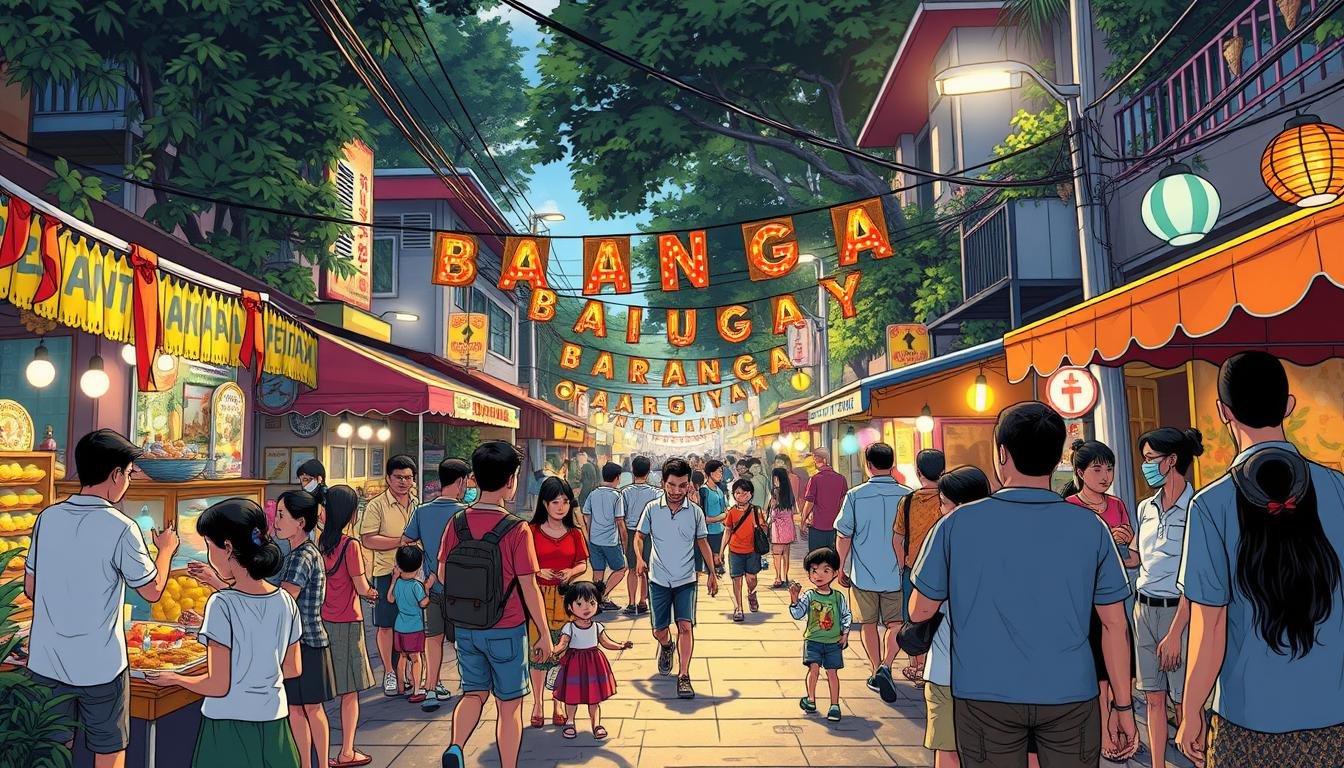What makes Barangay fiestas a vibrant expression of Filipino community spirit? These celebrations bring people together to honor their culture and traditions. In the Philippines, each region celebrates fiestas in its own unique way.
They have distinct rituals, dances, and prayers. This shows the spirit of bayanihan, which is all about collective effort and mutual support. The Sinulog Festival in Cebu and the Pahiyas Festival in Quezon attract thousands every year. They highlight the importance of community and celebration in Filipino culture.
Key Takeaways
- Barangay fiestas are a celebration of Filipino community spirit and culture.
- These fiestas bring people together to honor their traditions and heritage.
- The spirit of bayanihan is emphasized in Filipino festivals, promoting collective effort and mutual support.
- Fiestas are celebrated not just to honor tradition but also to reaffirm Filipino identity and heritage.
- The values promoted by fiestas, including generosity and unity, are essential aspects passed down to future generations.
- Fiestas create a strong sense of pride and belonging among Filipinos, showing the importance of community and celebration.
The Significance of Fiestas in Filipino Culture
Fiestas are a big part of Filipino culture, showing the country’s rich tradition and heritage. These celebrations highlight the importance of community, family, and cultural practices. The Philippines has over a hundred festivals, each unique to a particular region or town, showing the country’s vibrant cultural diversity.
Fiestas bring people together, promoting social bonding and a sense of belonging. They feature traditional music, dance, and food, which are key parts of Filipino tradition. The jeepney, a symbol of Filipino ingenuity, is often decorated and featured in fiesta processions, showing the country’s creative and resourceful spirit.
Some notable fiestas in the Philippines include the Sinulog Festival in Cebu, the Ati-Atihan Festival in Kalibo, and the MassKara Festival in Bacolod. These festivals attract thousands of attendees, both locals and tourists, and are a significant contributor to the country’s tourism industry. The following are some key features of Filipino fiestas:
- Traditional music and dance performances
- Delicious Filipino cuisine, such as adobo and lechon
- Vibrant processions and parades, featuring decorated jeepneys and floats
- Cultural booths and exhibits, showing the country’s rich heritage
Historical Roots of Fiestas
Fiestas in the Philippines have a long history, dating back to the Spanish colonial period. These celebrations were initially held to commemorate religious events and holidays. Over time, they evolved to incorporate local customs and traditions. Today, fiestas are an essential part of Filipino culture, promoting social unity, cultural heritage, and community pride.
Modern Interpretations of Cultural Practices
In modern times, fiestas in the Philippines have taken on new forms and interpretations. While traditional practices and customs are observed, many fiestas now incorporate contemporary elements, such as modern music and dance performances. This blend of traditional and modern cultural practices has helped to keep fiestas relevant and appealing to younger generations, ensuring the continuation of this important aspect of Filipino culture.
| Fiesta | Location | Features |
|---|---|---|
| Sinulog Festival | Cebu | Grand procession of the Santo Niño, street parties |
| Ati-Atihan Festival | Kalibo | 18-day celebration of tribal heritage, street dancing |
| MassKara Festival | Bacolod | Smiling masks, street dancing, food festival |
Common Elements of Barangay Fiestas
The Philippines is famous for its lively celebration of fiestas. These events are a big part of the country’s culture and community life. They honor patron saints and bring people together to socialize and strengthen bonds.
Barangay fiestas include parades, processions, traditional music, and dance. Food stalls, games, and other activities add to the fun. These celebrations are a chance for the community to show off their culture and traditions.
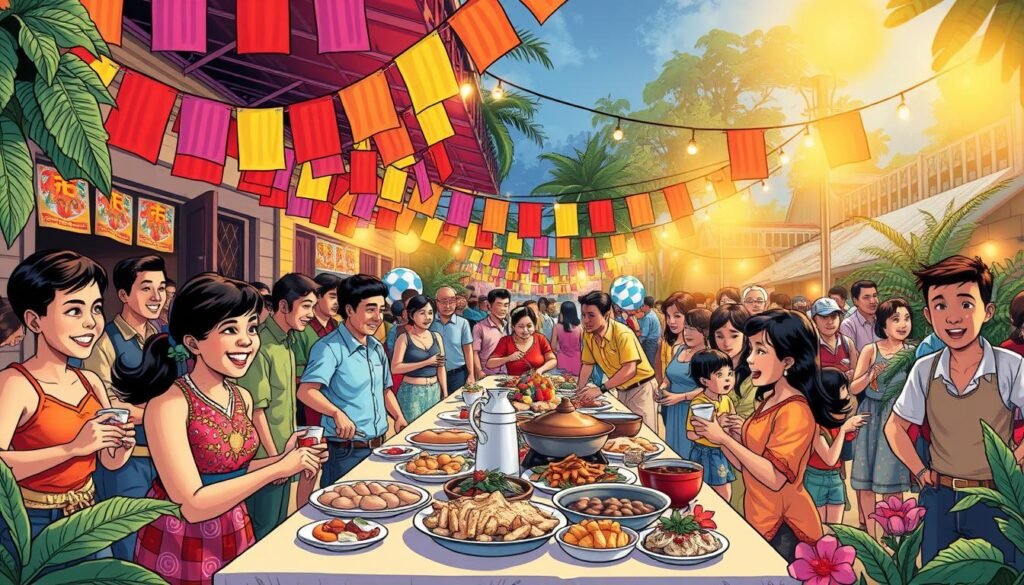
Parades and Processions
Parades and processions are key parts of barangay fiestas. They feature colorful floats, marching bands, and traditional dancers. The events are led by the patron saint’s image, carried through the streets by devotees.
Traditional Music and Dance
Traditional music and dance are vital to barangay fiestas. The air is filled with the sounds of drums, guitars, and other indigenous instruments. Traditional dancers move gracefully, showing off the rich cultural heritage of the Filipino community.
In conclusion, elements like parades, processions, traditional music, and dance make barangay fiestas lively and festive. They unite the community, foster social bonding, and highlight the country’s cultural richness.
Rituals and Traditions During Fiestas
Fiestas in the Philippines bring communities together. They celebrate culture and tradition. These events mix religious rituals with folk games, showing the country’s rich heritage.
Important rituals include the Santacruzan, a historical pageant, and the novena, a nine-day prayer. These highlight the deep cultural and traditional roots of Filipino fiestas.
Religious Observances
Religious events are key in Filipino fiestas. Towns and cities honor their patron saints with processions, masses, and traditional practices.
Folk Games and Competitions
Folk games and competitions are big parts of fiestas. They include cultural activities like traditional dances and music. These events help communities celebrate their heritage.
Examples of folk games and competitions are:
- Traditional dance competitions
- Music festivals featuring local artists
- Cooking contests showing regional flavors
The Role of Food in Fiestas
Food is a big part of Barangay fiestas. It brings the community together with traditional dishes and cultural heritage. At these events, traditional Filipino dishes like lechon, suman, and bibingka are served. These dishes have deep meanings and are enjoyed at community feasts and potlucks.
Food is more than just food in a celebration. It symbolizes community bonding and cultural identity. Sharing meals strengthens ties and shows belonging to the community. To learn more about food’s cultural significance, visit this website and explore the heritage of these dishes.
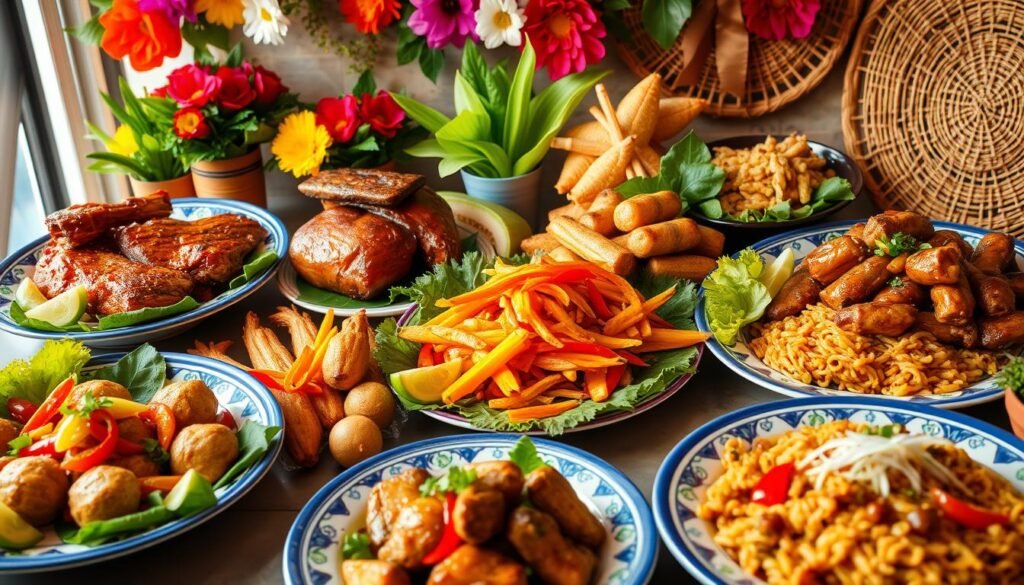
Traditional Dishes and Their Meanings
Some Filipino dishes are made just for fiestas. Their meanings are tied to the country’s history and culture. For instance, lechon is served at special times, meaning prosperity and good luck.
Community Feasts and Potlucks
Community feasts and potlucks are key parts of Barangay fiestas. They let people share food, stories, and laughter. These events build a sense of community and help people bond, which is important for the community’s well-being.
Economic Impact of Fiestas
Fiestas have a big impact on the local economy. They bring people together, creating community pride and social bonds. In the Philippines, each town and city celebrates its own fiestas.
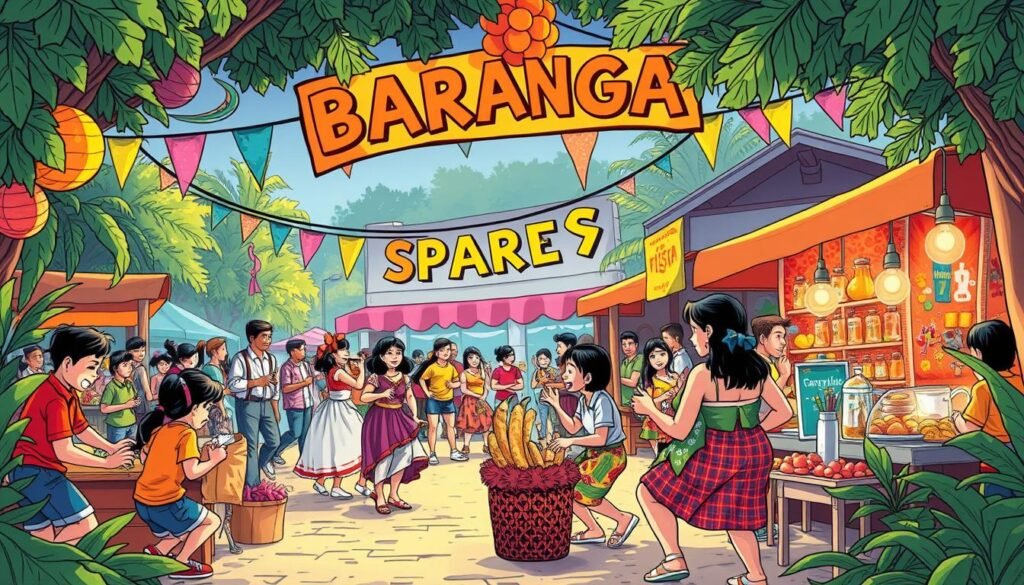
Local Business Involvement
Local businesses are key to fiesta success. They offer goods and services to visitors. For example, the Cagdianao Mining Corporation helps the Local Government Unit of Cagdianao.
This support boosts the local economy and aids in community growth.
Boosting Tourism and Community Pride
Fiestas draw tourists, helping the local government’s finances. They show off the town’s culture and traditions. This can extend the tourism season and help the industry.
By keeping local culture alive, fiestas give people a sense of identity. They nourish Filipino culture and bring economic benefits.
Planning a Successful Barangay Fiesta
Planning a barangay fiesta needs teamwork and careful planning. It’s a tradition that unites people and boosts community pride. To make it memorable, get everyone involved in planning, from choosing a theme to setting up activities.
Popular fiesta themes include culture, nature, food, unity, sports, and art. Culture and heritage themes are most common, making up 29% of choices. Nature and environment themes are also popular, at 14%. Here are some steps to follow:
- Form a planning committee to manage the event
- Set a budget and look for funding sources
- Pick a theme and plan activities that fit it
- Involve the community in planning to hear everyone’s ideas
A well-organized fiesta can unite the community and celebrate tradition. By working together and choosing diverse themes and activities, everyone can enjoy a meaningful celebration. 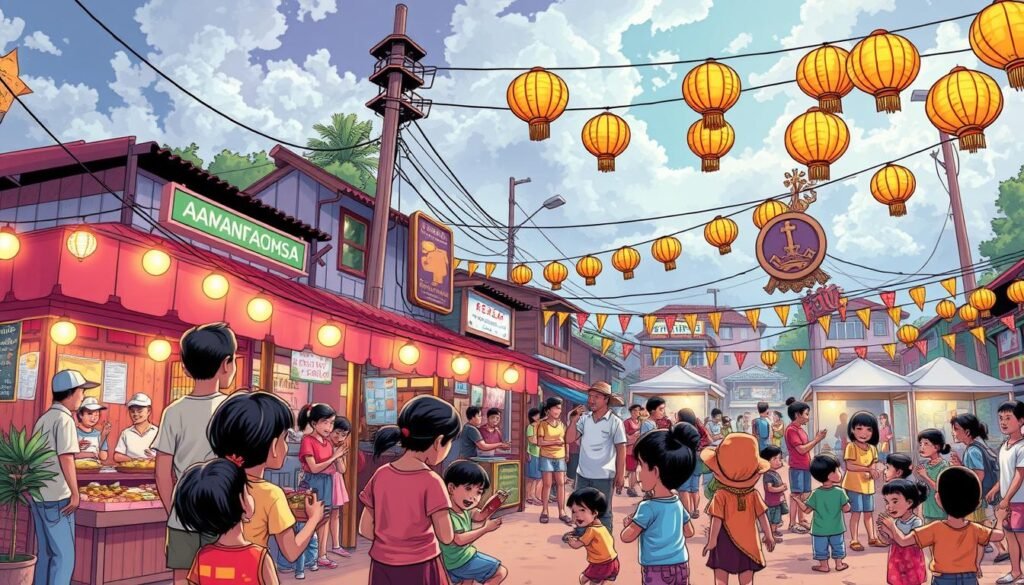
| Theme Idea | Percentage |
|---|---|
| Culture and Heritage | 29% |
| Nature and Environment | 14% |
| Food Fiesta | 14% |
| Community Unity | 14% |
| Sports | 14% |
| Art and Creativity | 14% |
By taking these steps and using different themes, communities can host a fiesta that honors tradition and strengthens unity.
Notable Fiestas Across the Philippines
The Philippines is famous for its lively fiestas. These events show off the country’s rich culture and tradition. From the Sinulog Festival in Cebu to the Ati-Atihan Festival in Aklan, each fiesta has its own special touch and meaning in Filipino culture.
Some notable fiestas include:
- Sinulog Festival in Cebu: a celebration of the Sto. Niño
- Ati-Atihan Festival in Aklan: a festival honoring the arrival of Malay datus
- Pahiyas Festival in Lucban: a celebration of the town’s patron saint, San Isidro Labrador
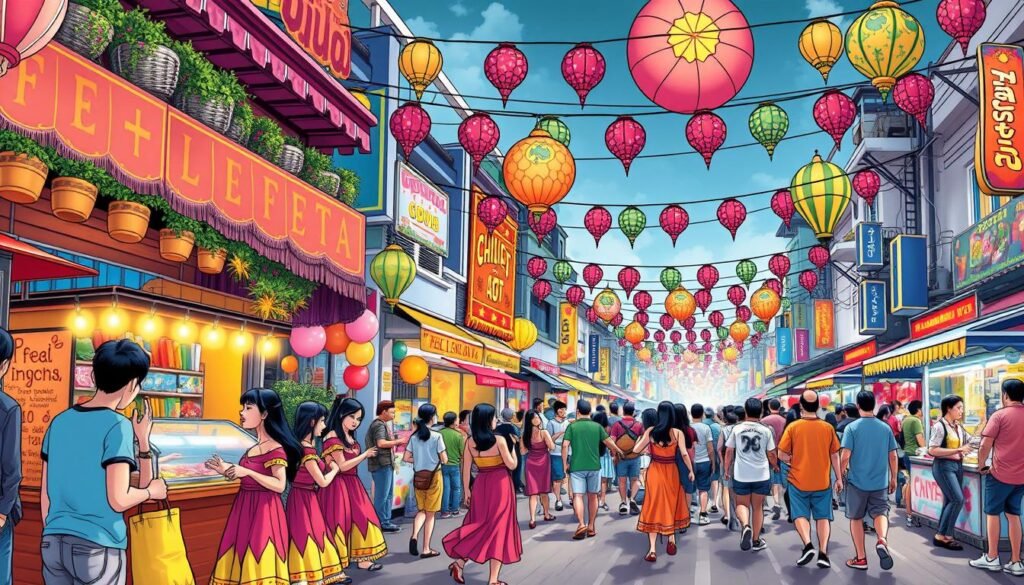
These fiestas are more than just a show of tradition. They celebrate the Filipino spirit. They unite people, promote culture and tradition, and offer a special experience for visitors.
| Fiesta | Location | Significance |
|---|---|---|
| Sinulog Festival | Cebu | Celebration of the Sto. Niño |
| Ati-Atihan Festival | Aklan | Honoring the arrival of Malay datus |
| Pahiyas Festival | Lucban | Celebration of San Isidro Labrador |
Challenges Faced in Celebrating Fiestas
Barangay fiestas are key to Filipino community spirit. They face many challenges, like super typhoon Haiyan. Yet, the community bounces back, showing its strength and adaptability.
The community works hard to organize these celebrations. They are a big part of Filipino culture. But, they must balance tradition and innovation, keeping the community spirit alive.
Impact of Natural Disasters
Natural disasters hit the community hard, affecting both buildings and morale. But, the fiesta becomes a beacon of hope and resilience.
Adapting to Modern Changes
The community also faces modern challenges, like noise from discorrals and karaoke. This has led to calls for noise laws. They must keep the celebration’s essence alive, honoring their cultural heritage.
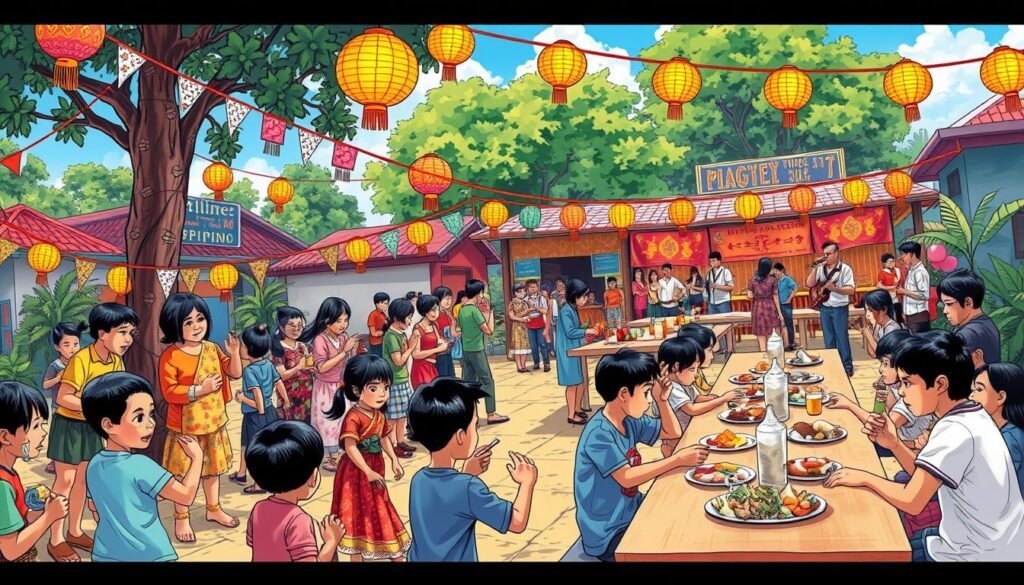
In conclusion, celebrating Barangay fiestas comes with many challenges. But, the community’s resilience and adaptability are inspiring. By embracing change, they ensure these celebrations continue, strengthening community bonds and celebrating their rich culture.
Gender Roles and Fiestas
In Barangay fiestas, gender roles are key to the festive vibe. These events are rooted in Filipino culture, with men and women having their own tasks. Women, for example, help prepare traditional foods and decorations, which are vital to the celebration.
Research shows women’s role in fiesta planning is essential. They help keep ancestral traditions alive. In some areas, women lead festivals like the Mallipa Festival and Salo Karajae. Their work shows their creativity and importance in community life.
Women’s Contributions to Fiesta Planning
Women do a lot in fiesta planning. They organize cultural festivals, spread the word about events, and perform in regional dances. Their role in dances shows their interest and deep cultural knowledge.
Men’s Involvement in Traditional Practices
Men have their own tasks in fiestas. They take part in folk games and competitions, which are key to the culture. Their involvement helps keep the community’s traditions alive.
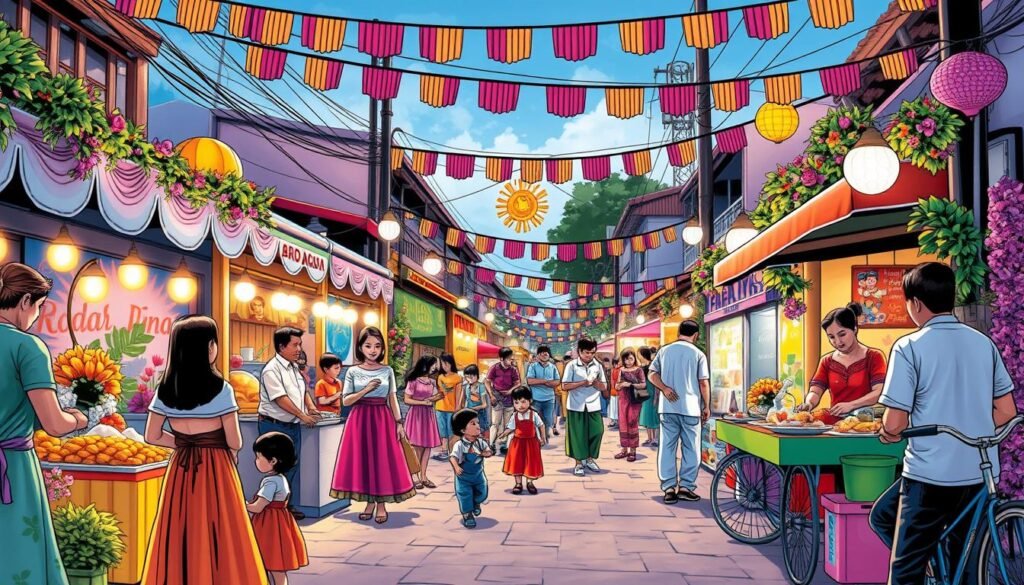
In summary, fiestas are a big part of Filipino culture, with gender roles being very important. Understanding these roles helps us see the culture and traditions of the community more clearly.
The Influence of Social Media on Fiestas
Social media is a big part of Filipino culture, seen during celebration of Barangay Fiestas. Over 90% of households use social media, making these events big online. People share their fiesta moments, photos, and videos on Facebook, Instagram, and Twitter. This makes the community feel closer together.
A study by Eventbrite shows social media’s big role in promoting local events. In the Philippines, it’s key for organizing and promoting Barangay Fiestas. It helps reach more people and build excitement for the event.
Some key statistics about social media’s role in fiestas include:
- 75% of Filipino families connect with friends and relatives through social media during the holiday season.
- 80% of New Year countdown events are live-streamed on social media platforms.
- 70% of individuals personalize their festive experiences through social media by sharing customized content.
Social media changes how we experience and interact at fiestas. It’s important to see its effect on the community and celebration. By using social media, organizers can make events more engaging and inclusive. They can also share local cultures and traditions worldwide.
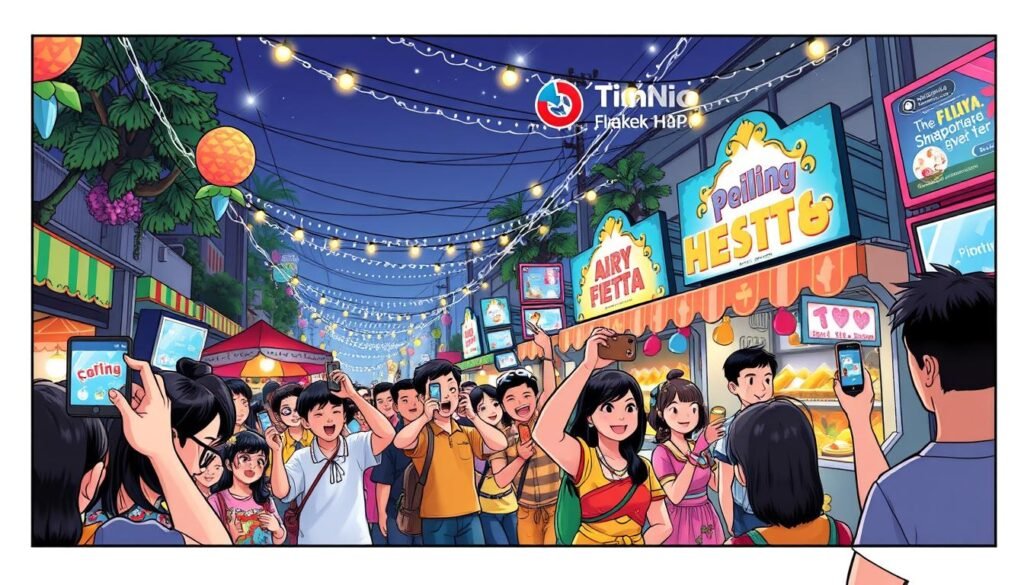
For more on the impact of colonialism on the Philippines, visit Sinaunang Panahon.
Creating Inclusivity in Barangay Fiestas
In the Philippines, Barangay fiestas celebrate community and culture. These events unite people, creating a sense of belonging. It’s key to include everyone and honor all cultures.
The Abaca Festival in Catanduanes is a great example. It shows how abaca is used in many ways, showing its value and cultural importance. This festival brings together community and culture, promoting inclusivity and celebrating heritage.
Creating inclusivity in Barangay fiestas involves several steps:
- Involve diverse community members in planning and organizing.
- Celebrate many cultures and traditions.
- Give everyone a chance to share their skills and talents.
By following these steps, Barangay fiestas can become more vibrant and inclusive. They celebrate community and culture together.
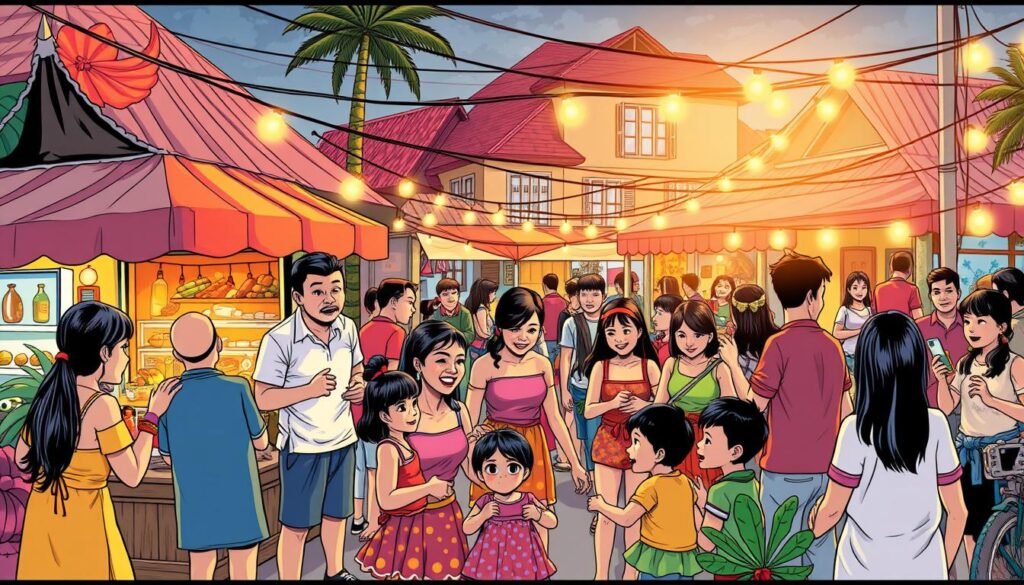
Creating inclusivity in Barangay fiestas is vital for community spirit and cultural exchange. By celebrating our differences, we build stronger, more united communities.
| Barangay Fiesta | Community Involvement | Cultural Significance |
|---|---|---|
| Abaca Festival | High | High |
| Sinulog Festival | Medium | Medium |
Environmental Considerations During Fiestas
In the Philippines, Barangay fiestas are a big deal. But, we need to think about how they affect the environment. Many festivals worldwide are now focusing on being green to cut down on pollution.
They’re using clean energy, setting up recycling centers, and encouraging green travel. Festivals are also pushing for food that’s good for the planet. This means less trash and cleaner air for everyone.
Here are some ideas to green up Barangay fiestas:
- Switch to energy-saving lights and sound systems
- Start recycling programs for all the trash
- Offer food that’s better for the planet and cut down on leftovers
- Get people to ride public transport or share rides
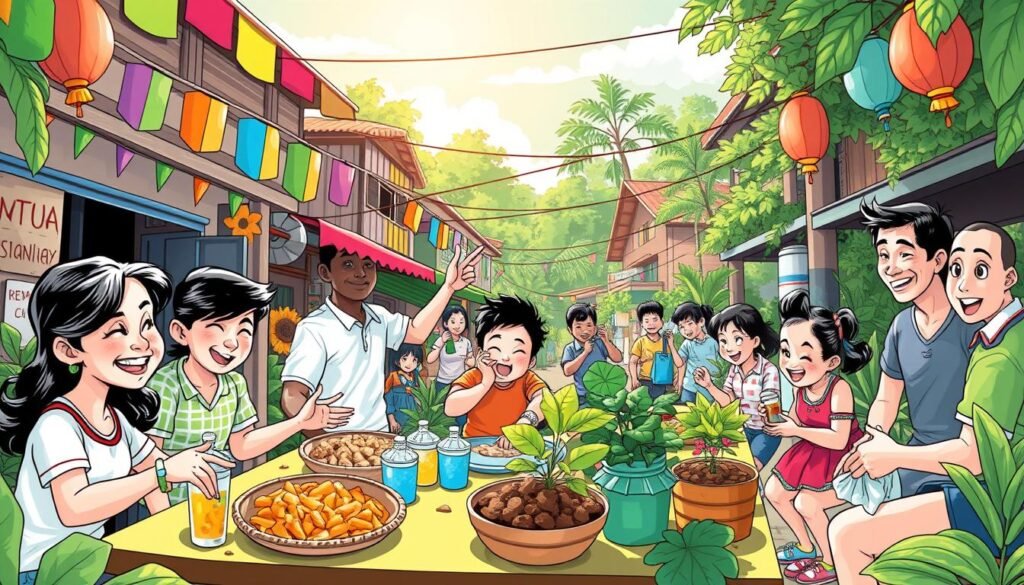
By doing these things, Barangay fiestas can be kinder to our planet. They can keep their traditions alive while being eco-friendly. As festivals grow, it’s key to focus on being green for the good of our communities and the earth.
| Festival | Environmental Initiative |
|---|---|
| Glastonbury | Using technology that converts urine into electricity |
| Boom festival | Reducing water consumption to 25 liters per person per day |
Fiestas as a Platform for Social Issues
Fiestas in the Philippines are more than just celebrations. They are a way to address social issues. The Philippine festivals show off the country’s rich culture. Each festival highlights the traditions and customs of different regions.
The community comes together for these festivals. It promotes unity and social awareness. For example, the 65th Annual Town Fiesta Celebration focused on community engagement and social issues. It showed how important festivals are in raising awareness.
Fiestas tackle social issues in several ways:
- They raise awareness about local causes and concerns.
- They encourage community involvement and participation.
- They offer a space for social commentary and critique.
As seen in the story of Mariano Llanera, festivals are key in promoting social change and culture.
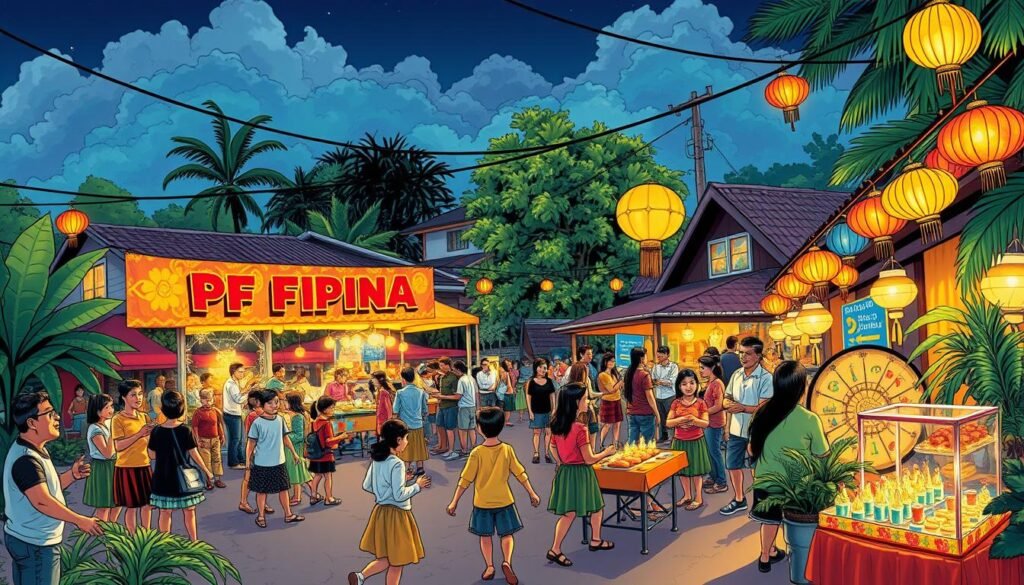
The Future of Barangay Fiestas
The Philippines is changing, but barangay fiestas are staying important. These events unite communities and help keep heritage alive. They also support social, cultural, and environmental goals. A study says fiestas should focus on culture, the environment, and working together.
Groups like the Intramuros Administration work hard to save Manila’s historic sites. The legacy of William Cameron Forbes shows how important infrastructure is to our culture.
Some key parts of a green barangay fiesta include:
- Socio-cultural elements, like traditional music and dance
- Environmental elements, like managing waste and using sustainable practices
- Multi-stakeholder collaborating strategies, like getting everyone involved
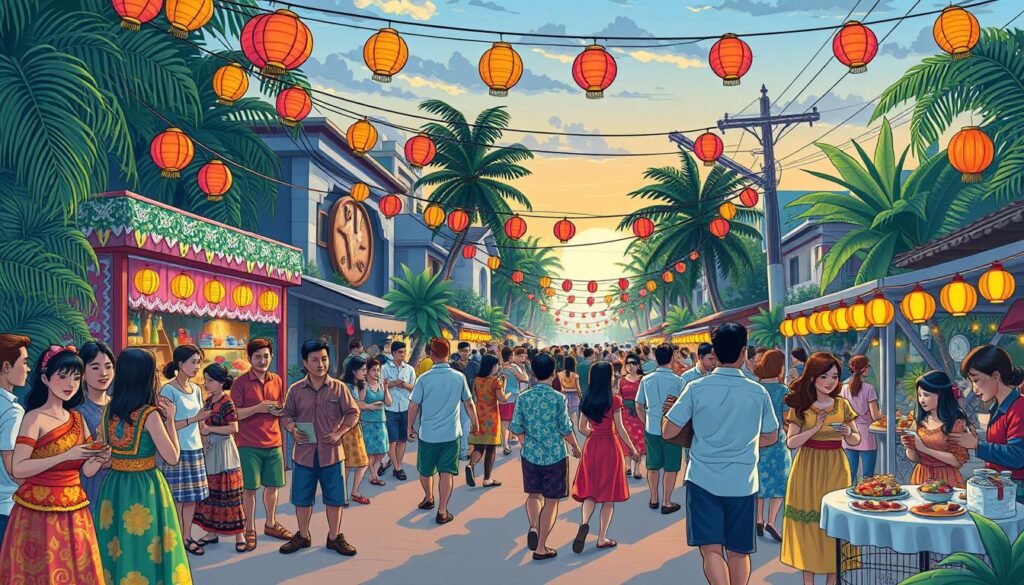
By adding these elements, fiestas can keep growing and help protect our culture. As the Philippines advances, it’s key to balance progress with preserving our heritage. This way, fiestas will remain special for generations to come.
Conclusion: Strengthening Community Ties Through Fiestas
The vibrant Barangay fiestas of the Philippines are key to building strong community ties. These celebrations keep cultural traditions alive and create lasting bonds among people. Studies show that fiestas greatly improve social connections and overall happiness.
Being part of local fiestas opens doors to more social interactions, trust, and help among neighbors. These events bring together people of all ages, teaching them about community service and caring for the environment. Fiestas also boost the local economy through spending and tourism, making the Barangay proud and prosperous.
In the Philippines, fiestas are a vital part of the culture, keeping community spirit alive. They strengthen the connections between people and create a sense of belonging. This makes the Philippines a vibrant and united nation for everyone who lives here.
FAQ
What are Barangay fiestas and how are they celebrated in the Philippines?
Barangay fiestas are big celebrations in Filipino culture. They include parades, music, dance, and feasts. These events bring people together, showing unity and friendship.
What is the historical and cultural importance of Barangay fiestas in the Philippines?
Barangay fiestas have a long history in the Philippines, starting with the Spanish era. They have changed over time but keep their cultural value. They honor local saints and traditions, showing community pride.
What are the common elements and traditions observed during Barangay fiestas?
These fiestas are known for their colorful parades and music. They also have dance, rituals, and games. These activities add to the festive mood.
How do food and community feasts play a role in Barangay fiestas?
Food is key in Barangay fiestas, with traditional dishes being a big part. Community feasts are also common. They highlight the joy of sharing and being together.
What is the economic impact of Barangay fiestas on local communities?
Barangay fiestas boost local economies by attracting visitors and supporting businesses. They also increase community pride and development. These events can also address social issues.
What are the challenges faced in celebrating Barangay fiestas, and how do communities adapt?
Celebrating fiestas can be tough, like dealing with natural disasters. But Filipino communities are strong. They find ways to keep their traditions alive and celebrate their spirit.
How do gender roles and dynamics play a role in Barangay fiestas?
Gender roles are important in fiestas, with women leading in planning and men in traditional practices. Their contributions are vital to the success and cultural value of the celebrations.
How has social media influenced the way Barangay fiestas are celebrated and shared?
Social media has changed fiestas, letting people share their experiences online. It helps spread awareness and appreciation for these local celebrations.
What steps are being taken to ensure the inclusivity and sustainability of Barangay fiestas?
Efforts are made to include everyone in fiestas and celebrate different cultures. There’s also a push for sustainable practices, like waste management, to keep these traditions alive.
What is the future of Barangay fiestas, and how are they being preserved for future generations?
The future of fiestas is bright, with a focus on keeping traditions alive while embracing new ideas. There’s a commitment to making fiestas meaningful for future Filipinos.
Source Links
- It’s Always Fiesta Time in the Philippines: A Lesson in Resiliency – https://fdnbayanihan.org/2018/06/30/its-always-fiesta-time-in-the-philippines-a-lesson-in-resiliency/
- Exploring the Philippines’ Colorful Festivals and What They Mean to Filipinos – https://medium.com/@trixiadonne/exploring-the-philippines-colorful-festivals-and-what-they-mean-to-filipinos-641bd2bb4a5b
- Bujong Bujong sa Kagjanaw 2024: A Celebration of Community, Culture — Nickel Asia Corporation – https://nickelasia.com/bulletin/bujong-bujong-sa-kagjanaw-2024-a-celebration-of-community-culture
- The Cultural Extravaganza Lives! Join the Celebration at the Annual Filipino Fiesta and Flores De Mayo – – https://thefilipinochronicle.com/2022/04/16/the-cultural-extravaganza-lives-join-the-celebration-at-the-annual-filipino-fiesta-and-flores-de-mayo/
- Why You Should Experience a Filipino Fiesta at Least Once – Pinas Culture – https://pinasculture.com/why-you-should-experience-a-filipino-fiesta-at-least-once/
- The tradition of fiestas – https://www.sunstar.com.ph/more-articles/the-tradition-of-fiestas
- 10 Things to Experience in A Barangay Fiesta – Pinoy Top Tens – https://topten.ph/2016/02/26/10-things-to-experience-in-a-barangay-fiesta/
- List of festivals in the Philippines – https://en.wikipedia.org/wiki/List_of_festivals_in_the_Philippines
- Why Fiesta In The Philippines Is A Celebration Like No Other – https://lakbaypinas.com/why-fiesta-in-the-philippines-celebration/
- The Fiesta in the Philippines – https://www.ccel.org/node/20428
- Fiesta Celebrations: Honoring Patron Saints and Community Bonds – Pinas Culture – https://pinasculture.com/fiesta-celebrations-honoring-patron-saints-and-community-bonds/
- The Role Of Food In Celebrations – FasterCapital – https://fastercapital.com/topics/the-role-of-food-in-celebrations.html
- The Role of Food in Religious Practices and Celebrations – https://medium.com/@MAMeer841/the-role-of-food-in-religious-practices-and-celebrations-b33ec13b4194
- The Economic Impact of Festivals on Small Towns – https://www.cis.tennessee.edu/sites/default/files/The Economic Impact of Festivals on Small Towns Gwen Shelton.pdf
- The Economic Impact of Festivals: How Regional Celebrations Boost Local Economies – Pinas Culture – https://pinasculture.com/the-economic-impact-of-festivals-how-regional-celebrations-boost-local-economies/
- PDF – https://research.lpubatangas.edu.ph/wp-content/uploads/2017/06/APJEAS-2017.4.2.02.pdf
- Barangay Fiesta – https://dahomlagonoy.weebly.com/dl-blogs/barangay-fiesta
- Answers to: How can i make a theme for a brgy fiesta – https://www.classace.io/answers/how-can-i-make-a-theme-for-a-brgy-fiesta
- No title found – https://www.holidify.com/pages/festivals-in-philippines-5406.html
- Festivals and Events in the Philippines – https://www.tropicalexperiencephilippines.com/events-festival-philippines
- The dark side of celebrating our ‘fiesta’ – https://www.philstar.com/nation/2010/07/16/593375/dark-side-celebrating-our-fiesta
- Dangerous fiesta celebrations – https://www.philstar.com/cebu-business/2008/04/22/57456/dangerous-fiesta-celebrations
- Gender Roles, Externalizing Behaviors, and Substance Use Among Mexican-American Adolescents – https://pmc.ncbi.nlm.nih.gov/articles/PMC2963473/
- PDF – https://jurnal.penerbitsign.com/index.php/sjt/article/download/v1i1-2/99/
- Impact of Social Media on Christmas and New Year Celebrations – https://www.myessaywriter.ai/examples/impact-of-social-media-on-christmas-and-new-year-celebrations
- The Influence of Social Media on New Year Celebrations – https://www.linkedin.com/pulse/influence-social-media-new-year-celebrations-myshishu-di2tc
- Fiesta as unifying force – Bicol Peryodiko – https://bicolperyodiko.com/2024/06/10/fiesta-as-unifying-force/
- PDF – https://pdp.neda.gov.ph/wp-content/uploads/2017/01/Chapter-7-Prepublication.pdf
- 10 Ways You Can Make Your Festivals More Environmentally Friendly – https://eclipse.global/make-your-festivals-environmentally-friendly/
- Festivals sector moves to make events greener – https://impact.economist.com/sustainability/social-sustainability/festivals-sector-moves-to-make-events-greener
- The Power of Festivals: Celebrating Filipino Heritage and Its Influence on the Contemporary Workforce – https://www.yoonet.io/insights/the-power-of-festivals-celebrating-filipino-heritage-and-its-influence-on-the-contemporary-workforce
- What is a festival and what types of festivals are there? – Meetmaps Blog – https://blog.meetmaps.com/en/what-is-a-festival-and-what-types-of-festivals-are-there/
- After the Sto. Domingo barangay fiesta, a look ahead – Zigzag Weekly – https://www.zigzagweekly.net/after-the-sto-domingo-barangay-fiesta-a-look-ahead/
- Pistang Pamana, Pistang Naaayon: A Socio-cultural and Enviro… – https://kneopen.com/Kne-Social/article/view/2407/
- Relationships between Community Festival Participation, Social Capital, and Subjective Well-Being in a Cross-Cultural Context – https://www.mdpi.com/2227-9032/11/16/2361
- Community festivals—Big benefits, but risks, too – https://extension.umn.edu/vital-connections/community-festivals-big-benefits-risks-too
- Strengthening Family Bonds through Festivals: A Guide for Parents – https://www.imeuswe.in/strengthening-family-bonds-through-festivals-a-guide-for-parents/

